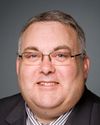Thank you, Mr. Chair, and committee members.
It's a privilege to be here and to present to you today. Hopefully we will get a better, more sane, realignment of boundaries for the province of Saskatchewan. I obviously, as well, in my indication to the committee, oppose the proposed boundaries and I'll lay out some of the reasons here now.
I am very much in support of the historical trading patterns, blended urban-rural, ex-urban kinds of boundaries that we've had in the past. I will indicate the biggest problems that I have with the current proposal.
Right from the get-go, Professor Courtney—I'll go right to this issue, I may have some questions on it later—had a fixed mindset and a determination before even a word of testimony was heard. In fact I had reported to me conversations that occurred at the orientation here in Ottawa before there were any meetings, before there were any witnesses heard at all, where Professor Courtney was talking adamantly of needing the urban-only boundaries in the province of Saskatchewan, particularly in the major cities of Saskatoon and Regina.
To me, that does a great disservice, a disrespect that denigrates the process, when one of the commissioners—a reputable, respected gentleman otherwise—has a mindset and a predetermination of having urban boundaries, and then tries to collect evidence to justify it afterwards. To me that is a disservice. He probably should have recused himself at the point that he realized he had this set, determined mindset from the get-go.
How else can one explain the very humongous ridings, for example, all the way from my boyhood home of Quill Lake, way across, looping around Saskatoon over to Rosetown, a stretch of probably three or four hours or more, depending on how heavy your foot is. How else do you explain that?
How do you explain their comments saying that these ridings, these newly proposed boundaries, are now no larger than the ones that presently exist in Desnethé—Missinippi—Churchill River, Cypress Hills—Grasslands, Souris—Moose Mountain, and the Yorkton—Melville ridings.
If you were to ask those members of Parliament.... Then they make the almost asinine statement that those members did not indicate that they were inadequately serving the needs of their constituents. What member of Parliament is going to say that? It's a fairly asinine comment, in my particular view.
You should talk to those MPs, in terms of chasing from one end to the other on weekends, away from Parliament here. Talk to the spouses of those MPs, as I have done, in terms of their having to be at events at opposite or disparate ends of those particular ridings. They talked in terms of using modern communications, which we all do, electronic and so on, but in a high-tech age we should also still use high-touch, that will always be the case.
The younger generation want to talk to you directly, middle-aged older people.... Imagine what it would have been like, if Jack Layton, in his last campaign—where he did remarkably for the NDP—had said, “I'm going to do this by Skype. I'm going to do it by the modern electronic means”. You would not catch the enthusiasm of a Jack Layton. You would not catch the excitement that he brought in that setting, or his charisma. You cannot possibly figure to serve the needs of constituents simply by Skyping and those things, which the House of Commons doesn't allow anyhow.
What would it have been like if Justin Trudeau, instead of travelling extensively to bars and malls and schools, and everywhere across the country, would have said, “I'll do it by Skype”. Of course, he uses all the modern technology, but that is no replacement for direct contact with people, and Justin Trudeau was all across the country. I point out Jack Layton and Justin Trudeau, of late, and how they went across the country, first-hand, meeting people. There's something captured that way that you don't capture electronically.
I have some letters in hand here. There's the one that's maybe been referenced here before, from the mayor of the city of Saskatoon, and Mr. Fougere as well has indicated his opposition. Mr. Atchison, the mayor of Saskatoon, says it makes no sense. It does not promote unity. It doesn't work with the regional kind of thing that we're encouraging in Saskatchewan.
I have a letter here as well, that you have in French and English, from the mayor of Warman, a city just on the edge of Saskatoon, and she opposes it as well. She says that when we think and work regionally now.... Recently there was a water main break in Saskatoon and they were on a boil water advisory in Saskatoon, but also in the cities of Warman and Martensville, because we have a common water system and a common infrastructure tying them together. Now they've cut those communities off from one another. Alan Thomarat, who is the CEO of the Home Builders' Association in Saskatchewan, makes this point well in a piece that was in your package, too.
Lastly, one of the councillors in my riding, Randy Donauer by name, also opposes it. He talks about the need to work together regionally, and more and more we're doing that as the cities and towns in the area close to Saskatoon.
I think it's never too late for these individuals to do the right thing and reverse themselves. I have a proposal of a bare minimum that could be done, but I can come to that later, in the question period.






